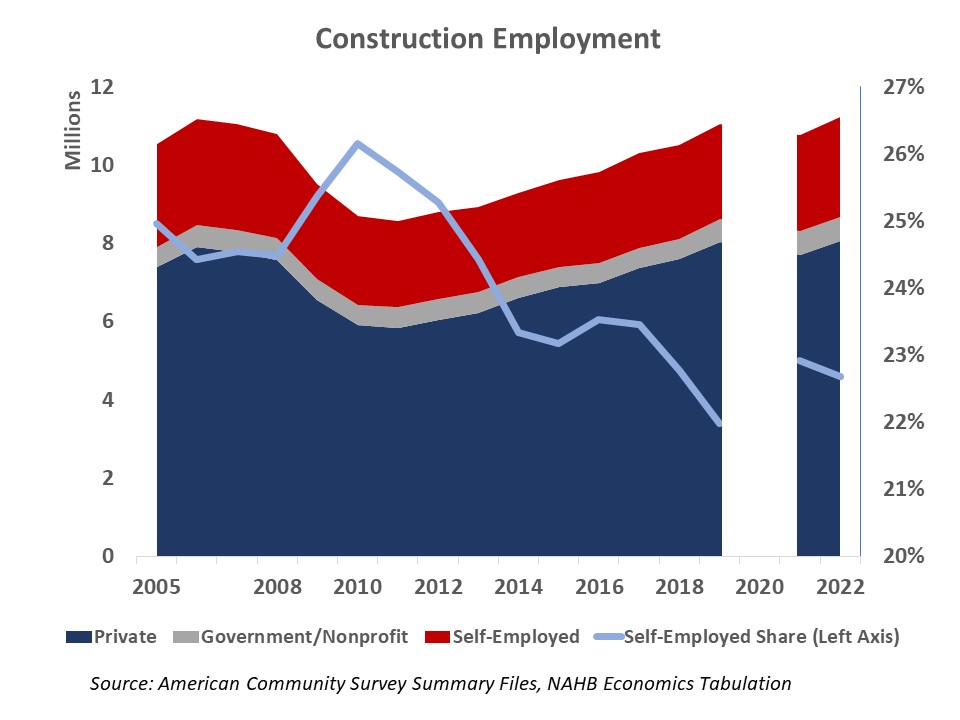Close to 23% (or over 2.5 million) of workers employed in construction are self-employed, according to the 2022 American Community Survey (ACS). As industry payrolls expanded in 2022, the share of self-employed inched down. However, the share remained higher than it was in 2019, before the pandemic rattled the labor market. Even though the COVID-19 pandemic boosted self-employment across all industries, construction self-employment rates remain significantly higher than an economy-wide average of 10% of the employed labor force.
Compared to the elevated readings of the Great Recession, when over a quarter of the construction labor force was self-employed, the current construction self-employment rates are lower. This is consistent with the counter-cyclical nature of construction self-employment. Under normal circumstances, self-employment rates rise during an economic downturn and fall during an expansion. This presumably reflects a common practice among builders to downsize payrolls when construction activity is declining. In contrast, builders and trade contractors offer better terms for employment and attract a larger pool of laborers to be employees rather than self-employed when workflow is steady and rising.

Stacking construction self-employment rates against NAHB’s measure of labor shortage – the share of builders reporting shortages averaged over the nine trades (carpenter-rough, carpenter-finished, electricians, excavators, framing crews, roofers, plumbers, bricklayers/masons, and painters) – reveals that self-employment becomes less prevalent when construction labor shortages worsen. Thus, persistent labor shortages of the last decade is another contributing factor and helps explain why self-employment rates have been trending lower.

The COVID-19 pandemic disrupted this natural cycle with self-employment rates rising during the post-pandemic housing boom, when the labor shortages became particularly acute. It is likely that higher self-employment in construction post-pandemic reflects divergent trends within the industry – a faster V-shape recovery for home building and remodeling and a slower delayed improvement for commercial construction that is less dependent on self-employed.
It is also possible that some construction employees laid off during the COVID-19 recession of early 2020 became self-employed. Similarly, and consistent with economy-wide “Great Resignation” trends, some workers might have chosen self-employment because it offers more independence and flexibility in hours, pay, type and location of work. Given the widespread labor shortages in construction, securing a steady workflow was less of a concern for construction self-employed in post-pandemic times.
Since the 2020 ACS data are not reliable due to the data collection issues experienced during the early lockdown stages of the pandemic, we can only compare the pre-pandemic 2019 and post-pandemic 2021-2022 data (hence the omitted 2020 data in the charts above). As a result, it is not clear whether self-employed in construction managed to remain employed during the short COIVD-19 recession or recovered their jobs faster afterwards, compared to private payroll workers. It is also unclear whether the booming residential construction sector attracted self-employed workers from other more vulnerable or slow recovering industries, including commercial construction.
Examining cross-state variation provides additional insights into construction self-employment rates. Montana and Nevada constitute two opposites, with Montana registering the highest (36%) and Nevada showing lowest (11%) self-employment rates in construction. The substantial differences likely reflect a predominance of home building in Montana and a higher prevalence of commercial construction in Nevada.

The New England states are where it takes longer to build a house. Because of the short construction season and longer times to complete a project, specialty trade contractors in these states have fewer workers on their payrolls. The 2012 Economic Census data showed that specialty trade contractors in Montana, Maine, Rhode Island, Vermont, Idaho, and New Hampshire have the smallest payrolls in the nation with five to six workers on average. The national average is close to nine workers. As a result, independent entrepreneurs complete a greater share of work, which helps explain the high self-employment shares in these states.
Discover more from Eye On Housing
Subscribe to get the latest posts sent to your email.
